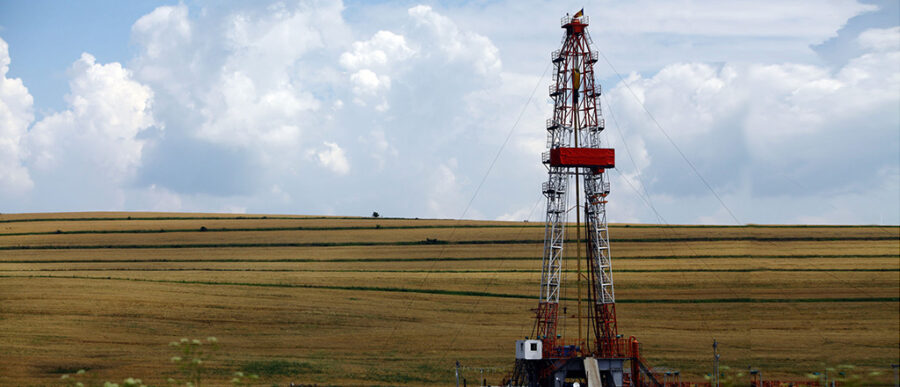The fracking boom in the U.S. is a boon for drivers and other consumers, cutting prices for gasoline, heating oil and other oil-based products.
But what has it done for investors?
New research by two Wharton professors and a colleague from the Simon School of Business at the University of Rochester shows the fracking boom added $2.5 trillion to stock values in the U.S. from 2012 through 2014, out of a $16 trillion gain in that period. That’s trillion, with a T.
Oil fracking uses water and chemicals under high pressure to fracture shale rock formations deep underground to release oil or gas that would be too expensive to extract with traditional wells. An established technology in gas drilling, Fracking has in recent years been combined with advances in horizontal drilling for broader access to oil fields as well. Horizontal wells, drilled by a bit steered from the surface, radiate from a central borehole like spokes of a bicycle wheel.
The result is more oil or gas pulled from the ground – a supply boom that has been a gold mine for producers even while driving prices down. It has been difficult, however, to measure the boom’s true financial benefits amid all the factors affecting the markets and economy.
“What is the benefit to the U.S. Economy from exploiting this technology broadly, both in terms of its contribution to oil prices and also to creating jobs?” asks Wharton finance professor Nikolai Roussanov, describing the project’s goal.
One way to look at the issue is to focus on stock market values. But a simple tally of share prices among shale-oil firms provides a picture blurred by factors other than the “technology shock” from fracking. So Roussanov, along with Wharton finance professor Erik Gilje and The Simon School’s Robert Ready, looked at stock prices around the time of announcements related to fracking.
The researchers created a portfolio of stocks in industries significantly affected by shale oil, giving more weight to stocks that proved to be more strongly affected by announcements. “We use this portfolio as an asset-price proxy for the value of shale-oil development and assess the explanatory power of this portfolio for market returns over different time periods,” they write in their paper, “Fracking, Drilling and Asset Pricing: Estimating the Economic Benefits of the Shale Revolution.”
“Using the market reaction to the news allows us to estimate the exposure of various assets to the underlying unobservable shocks,” the authors write. “We use the shale-mimicking portfolio to identify the component of aggregate market fluctuations that can be attributed to shale technology shocks.” In addition to industries involved in oil production, the index included ones heavily dependent on fuels, such as airlines and railroads.
Unforeseen Developments
The work focused on oil rather than gas fracking because the oil techniques are more recent, Roussanov said. Fracking for oil is particularly interesting because the breakthrough came as a surprise, the effect was very large and was initially confined to a small number of firms that could be easily identified for use in the shale-oil index, he and his colleagues write.
“What is the benefit to the U.S. Economy from exploiting this technology broadly, both in terms of its contribution to oil prices and also to creating jobs?” –Nikolai Roussanov
“Over the five years following the Great Recession (2009 through 2014) the U.S. equity market capitalization roughly doubled, despite fairly anemic rates of growth in the real economy,” the three researchers write, noting that U.S. oil production soared over the same period because of fracking.
“These were developments that were not foreseen,” Gilje says. Because of that, he adds, share prices did not already reflect this technology, assuring the link between announcements and share gains would be clear.
To tease out the role of oil fracking, the research looked at share price changes “on dates when significant announcements are made by the key firms involved in shale oil development.” That included announcements on earnings and new shale field discoveries. “We looked at particularly salient events that occurred in this sector, and we looked at the stock market reaction to these events using a broad cross-section of industries,” Roussanov says.
The study found that the shale index rose in tandem with the number of active wells, the rising productivity of the average well, and total oil production from the shale fields.
On July 31, 2013, Pioneer Natural Resources, a shale oil producer, announced a successful well test producing 1,712 barrels of oil and gas a day, most of it oil, indicating the West Texas field, the second largest in the world, could be more productive than expected. “Pioneer’s stock price increased 12.2 % on this announcement, adding $2.7 billion to the firm’s enterprise value,” the researchers write.
Positive news of this sort boosts the prospects of oil producers, equipment suppliers and other firms that benefit from rising oil sales, and it enriches businesses that buy oil, as well as households and companies that supply goods and services to ordinary consumers who will spend more on other things. It can hurt stocks of competitors like coal companies.
”In many cases, a single positive well result for a reservoir can indicate the potential for hundreds of follow-on wells, which can have billions of dollars of [benefit] for a given company,” they write.
In another case, OPEC announced in late 2014 that it would not cut production in response to lower prices. Oil prices fell 10% as a result and the researchers’ shale index dropped 8%. By looking at how various industries were affected by the announcement, the study verified that its index was capturing effects of technology news and not just changes in oil prices. In another validity check, the researchers looked at the shale index alongside moves of European stocks, which are not exposed to shale oil. Again, this showed the index was reflecting technology shock rather than moves in the broad stock market.
Ripple Effects
The researchers used various techniques to control for other factors that might have influenced those share-price gains, such as coincidence, oil price changes and interest rate announcements by the Federal Reserve.
“Industries that benefit most from shale have grown in their employment since 2012 by about half a percentage [point] more per year.” –Erik Gilje
“In total, we find that shale oil development is responsible for a roughly $2.5 trillion of the increase in stock market value during this [2012-2014] time period,” they conclude. “We find that our shale exposure proxy has no explanatory power in earlier time periods when shale oil production was virtually nonexistent.”
The study also found that shale-oil development correlated with events in the real economy such as employment growth, especially in big fracking states like Texas, South Dakota, Oklahoma, Colorado and New Mexico. “Industries that benefit most from shale have grown in their employment since 2012 by about half a percentage [point] more per year,” Gilje notes.
They calculated that price declines from larger oil supplies saved businesses and households about $131.4 billion per year. Over the long term that would be enough to account for the $2.5 trillion in stock market gains identified in the study, they write.
Stock price gains are just part of the economic benefit from fracking, Roussanov notes, since this number does not capture things like ripple effects from the extra consumer and business spending.
But putting a number to the stock market gain should help in calculating tradeoffs as regulators and lawmakers consider new rules for the fracking industry, Roussanov says. Critics worry the process pollutes air and water and can even trigger earthquakes.
“The recent stock market data indicates that what’s good for the oil sector ends up being good for the stock market as a whole,” Roussanov notes.



